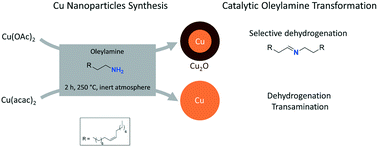Influence of the copper precursor on the catalytic transformation of oleylamine during Cu nanoparticle synthesis†
Abstract
For optimal use of copper nanoparticles in catalysis, in-depth understanding of the reaction mechanisms and fine characterization of final products are equally relevant. Indeed, both have a direct impact on the nanoparticle core and surface. So far, most insights come from characterization techniques focusing on the inorganic component, i.e. the nanoparticle core. Molecular techniques are often overlooked and the reactions alongside the reduction of the copper precursor are not properly understood. Such understanding is mandatory to properly interpret the nanoparticle behaviour in catalytic processes. Here, copper nanoparticle synthesis was studied by thorough characterization of the organic reactions happening during the synthesis, quantitatively by 1H nuclear magnetic resonance (1H NMR) and qualitatively by infra-red spectroscopy (IR) and electrospray ionisation-mass spectrometry (ESI-MS). The reduction of copper(II) acetate (Cu(OAc)2) by oleylamine resulted in a high amount of water and few by-products while the reduction of copper(II) acetylacetonate (Cu(acac)2) resulted in a low amount of water and many products. The resulting nanoparticles showed different abilities to further dehydrogenate and transaminate oleylamine in the synthesis reaction pot. This was explained by the presence of a copper oxide phase in the nanoparticles prepared from copper acetate.

- This article is part of the themed collection: Emerging Investigator Series


 Please wait while we load your content...
Please wait while we load your content...